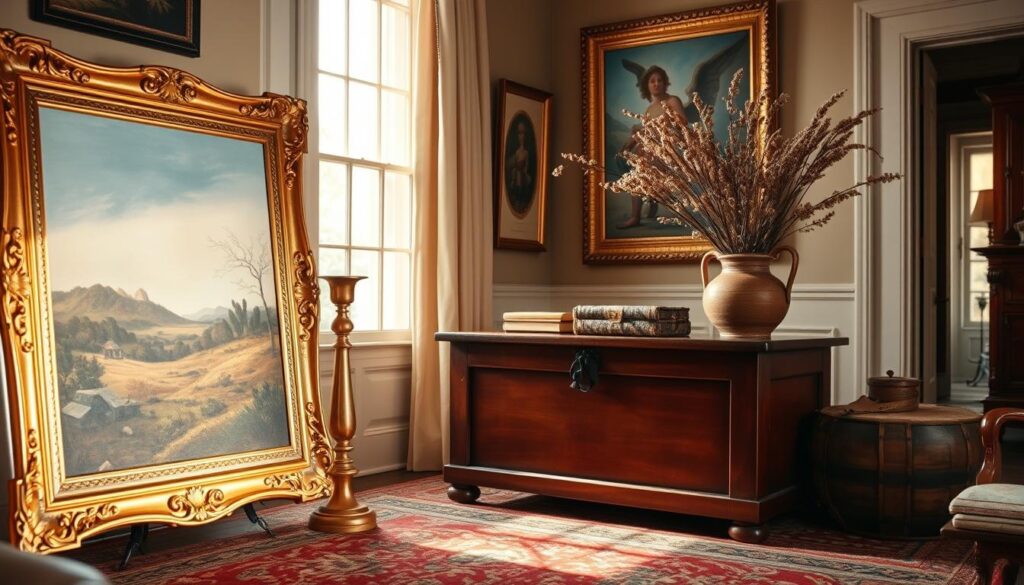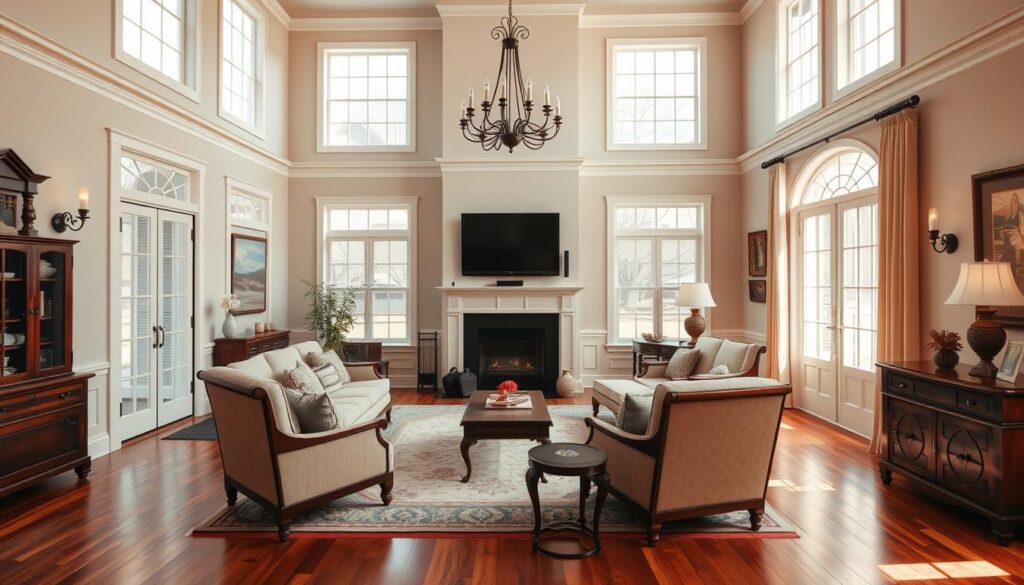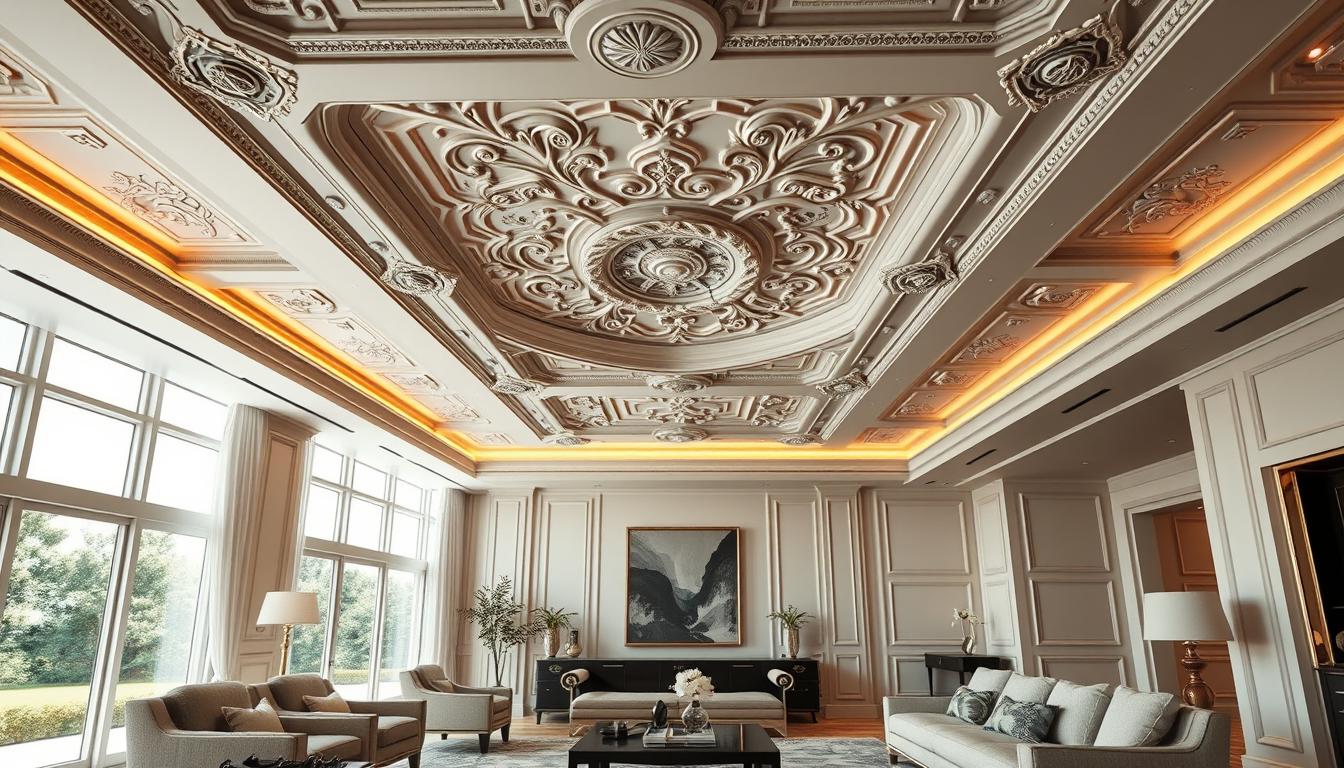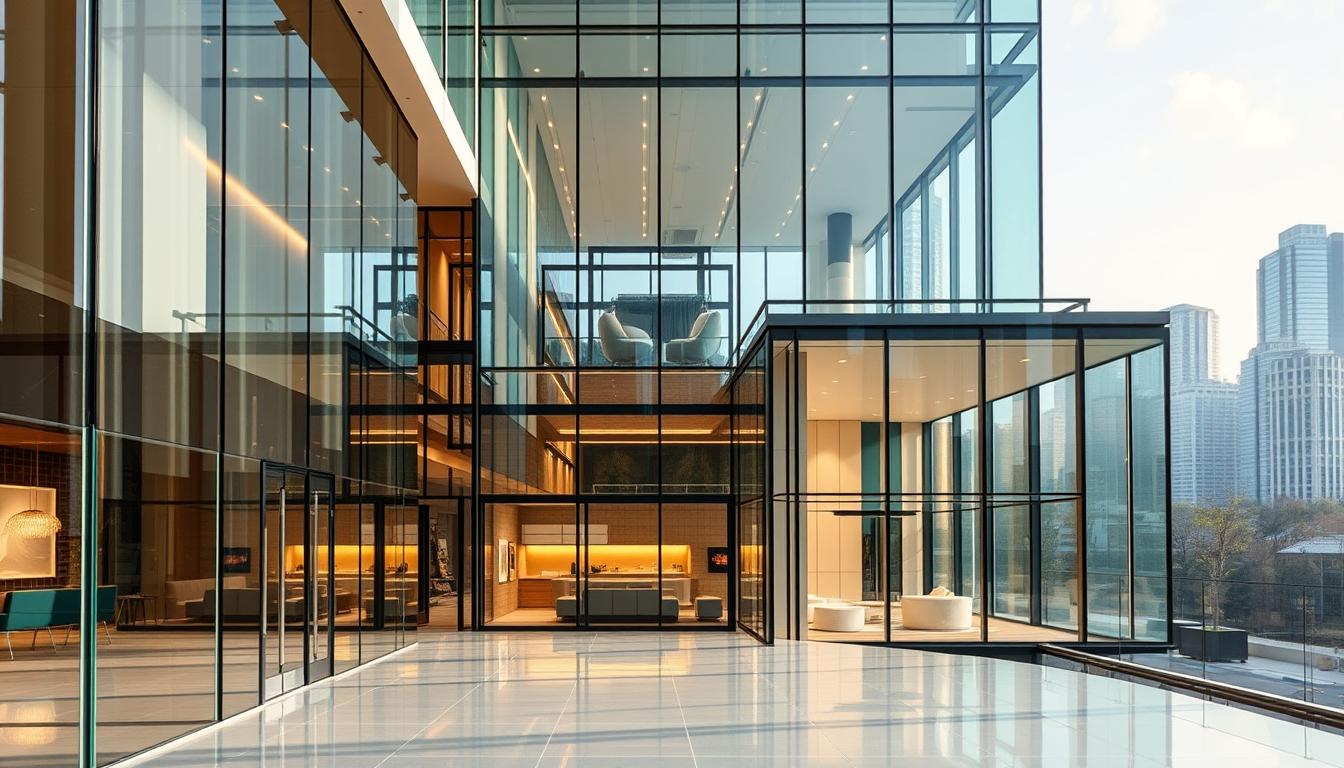The charm of traditional colonial home decor comes from its simplicity and rich history. Did you know that the colonial era in the US inspired a design that’s still loved today? It’s known for classic furnishings and timeless elegance.
We’ll show you how to create the perfect colonial-style living space. It’s all about understanding the past and using key elements that make up the colonial style homes interior.
Key Takeaways
- Understanding the historical context of colonial-style decor
- Identifying key elements that define colonial-style interiors
- Applying traditional design principles to modern living spaces
- Selecting furnishings that reflect the colonial era’s aesthetic
- Creating a timeless and elegant home interior
Understanding Colonial Style Homes
Learning about colonial-style homes is key to loving their interior design. These homes have a long history, starting with the early American colonies. They were influenced by many European styles.
Historical Background
The colonial era in the US was a mix of cultures, leading to a unique style. Early homes were simple and practical, fitting the settlers’ needs. As the colonies grew, so did their homes, adding European touches.
Knowing the history of colonial homes helps us understand their design. They used local materials and traditional skills. Colonial interior design often included wooden furniture, which was both strong and beautiful.
Key Architectural Features
Colonial homes stand out with their symmetrical fronts, rectangular shapes, and classic details. Inside, you’ll find central hallways and rooms on either side. This layout brings order and balance.
These homes were built with natural materials like wood and brick. These materials made the homes strong and added warmth. Colonial furniture was made from solid wood. It was both useful and cozy, meeting the household’s needs.
By grasping the history and architecture of colonial homes, we can truly appreciate colonial interior design. It still shapes home decor today.
Core Elements of Colonial Home Interiors
To get the authentic colonial look, knowing the key parts of colonial home interiors is vital. Colonial style homes are loved for their timeless beauty. This beauty comes from their interior design.
Traditional Color Palettes
Colonial homes are known for their soft, muted colors. Think pale peaches, pinks, soft blues, greens, yellows, and browns. These colors bring a sense of elegance and warmth to the home.
Choosing colors for your colonial home should reflect its history. Homes in the Northeast often have cooler tones due to the climate. Homes in warmer areas might have brighter colors. Design experts at Nelson Design Group say knowing these details is crucial for a true colonial look.
Common Flooring Options
Flooring is a big part of colonial home design. Wide-plank hardwood floors, like oak, maple, or pine, are common. These floors are durable and add warmth and character.
Some colonial homes also have brick or stone floors, like in entryways or kitchens. The right flooring can make or break the look of your home. Choosing the right material is key to keeping the classic colonial style.
Key considerations for colonial-style flooring include:
- Wide-plank hardwood for a traditional look
- Durable materials that can withstand heavy use
- Historical accuracy in terms of material and installation methods
By focusing on these core elements, you can make a colonial home interior that’s both real and welcoming. Whether you’re fixing up an old colonial or building a new one, knowing these design principles is crucial for the classic colonial style.
Essential Furniture Pieces for Colonial Interiors
Colonial decor is all about traditional furniture that’s both functional and charming. When decorating a colonial-style home, choose pieces that show the era’s simplicity and skill.
Classic Wooden Furniture
Wood was a key material for Colonial-era furniture because it was affordable and practical. Thus, classic wooden furniture is a must-have for colonial interiors. Items like oak dressers and walnut tables were made with great care, boasting simple yet beautiful designs.
To get that true colonial vibe, look for wooden furniture with:
- Straightforward, minimalist designs
- Rich, warm wood tones
- Intricate details like carvings or moldings
Upholstered Seating Styles
Upholstered seating was also key in colonial interiors. Styles like Queen Anne and Chippendale chairs were favorites, known for their detailed upholstery and strong wooden frames.
When picking upholstered seating for a colonial home, aim for pieces with:
- Traditional patterns like florals or stripes
- High-quality fabrics such as velvet or linen
- Classic designs that reflect the era’s influence
Mixing classic wooden furniture with elegant upholstered seating creates a colonial interior that’s both genuine and welcoming.
Lighting Choices for a Colonial Aesthetic
Lighting is key in colonial home decorating. The right lights can make your home feel like it’s from another time. In colonial homes, lights were not just for seeing; they were also decorative.
To get the colonial look right, pick lights that were popular in the 17th and 18th centuries. We’ll see which lights fit this classic style best.
Chandeliers and Ceiling Fixtures
Chandeliers and ceiling lights were big in colonial homes. They brought elegance and light. Materials like brass, bronze, and crystal were used, along with detailed designs.
“A good chandelier can be the highlight of your colonial home,” it adds light and style. In the past, chandeliers had candles or oil lamps for a warm glow. Now, you can find electric ones that look like the old ones. Choose a chandelier that fits your room and decor well.
Table and Floor Lamps
Table and floor lamps were also important in colonial lighting. They were made from wood, metal, or ceramic and had simple yet elegant designs. For a colonial look, find lamps with classic shapes and ornate details.
Lamps with metal or ceramic shades were common back then. You can also find lamps with a rustic or distressed look to add age and character. The goal is to find lamps that look good and work well.
Choosing the right lights can make your colonial home warm and welcoming. Whether it’s a big chandelier or a simple table lamp, the right lighting brings your colonial style to life.
Textiles That Enhance Colonial Decor
In the colonial era, textiles were key in setting the look of homes. They mixed function with beauty. Natural elements were chosen for their lasting quality and beauty.
Materials like jute, wool, and silk were top picks for colonial decor. They were tough and added warmth and texture to spaces.
Curtains and Drapes
Curtains and drapes were big in colonial homes. They were both useful and decorative. Heavy fabrics like velvet and damask made luxurious drapes. These could keep rooms warm and dark.
The patterns and colors of curtains and drapes mattered a lot. Traditional designs often had floral patterns, stripes, and geometric motifs. These were in rich, muted colors that matched the room’s color scheme.
Rugs and Textiles
Rugs and other textiles were crucial in colonial decor. Natural fiber rugs, like those from sisal or jute, were loved for their lasting quality and natural look.
To show the variety of textiles in colonial decor, here’s a table:
| Textile Type | Material | Common Patterns |
|---|---|---|
| Curtains/Drapes | Velvet, Damask, Silk | Floral, Stripes, Geometric |
| Rugs | Sisal, Jute, Wool | Natural, Braided, Floral |
| Upholstery | Wool, Velvet, Leather | Stripes, Floral, Geometric |
By using these textiles in our homes, we can make a cozy, welcoming space. This space honors the traditional look while meeting today’s needs.
Incorporating Colonial Art and Accessories
To truly capture the essence of colonial decor, one must carefully select colonial art and accessories. These items should reflect the era’s simplicity and practicality. American colonists decorated their homes with items collected while traveling or inherited from ancestors. These personal touches added warmth and told stories of their heritage and travels.
When choosing colonial art and accessories, consider a few key elements. The right pieces can enhance classic colonial interiors, creating a cohesive and inviting atmosphere.
Wall Paintings and Portraits
Wall paintings and portraits were staples in colonial homes. These artworks often depicted family members, historical events, or landscapes. They were decorative and helped preserve family history and cultural heritage.
- Family Portraits: Commissioned portraits of family members were common, serving as a way to record family history.
- Landscape Paintings: Landscapes and seascapes were popular, often reflecting the colonists’ connection to nature and their surroundings.
- Historical Scenes: Paintings of historical events or biblical scenes were also prevalent, adding an educational element to the decor.

Decorative Accessories
Decorative accessories played a significant role in colonial decor. They added texture and interest to living spaces. These items were often functional as well as decorative, reflecting the practical nature of colonial life.
Some common decorative accessories include:
- Ceramics and Pottery: Handmade ceramics and pottery were used for both practical purposes and as decorative pieces.
- Metalwork: Items like candlesticks, door hardware, and other metalwork added a touch of elegance and sophistication.
- Textiles: Embroidered linens, quilts, and other textiles were not only functional but also served as decorative elements, showcasing the craftsmanship of the colonial era.
By carefully selecting and incorporating these colonial art and accessories, homeowners can create a warm and inviting space. This space honors the simplicity and practicality of the colonial era while reflecting their personal style.
Wall Treatments in Colonial Homes
Colonial homes used different wall treatments to make them cozy and welcoming. We’ll look at how these treatments helped create the traditional colonial style and vintage colonial decor.
Wainscoting Techniques
Wainscoting was a key feature in colonial homes, adding texture and interest to the walls. Traditional wainscoting involved paneling the lower walls, up to chair rail height, with wood. This made the walls warmer and protected them from damage.
There were many wainscoting techniques, like raised panel, flat panel, and board and batten. Raised panel wainscoting had panels raised above the frame, adding a decorative touch. Flat panel wainscoting was simpler, with flat panels for a clean look.
| Wainscoting Technique | Description | Aesthetic Appeal |
|---|---|---|
| Raised Panel | Panels raised above the frame | Decorative, classic |
| Flat Panel | Simple, flat panels | Understated, clean |
| Board and Batten | Vertical boards with battens | Rural, rustic |
Wallpaper Patterns
Wallpaper was also popular in colonial homes, adding pattern and decoration. Traditional wallpaper patterns included stripes, florals, and toile. These patterns added elegance and sophistication.
The wallpaper pattern choice depended on the room’s purpose and desired look. For example, striped wallpaper was often used in dining rooms and hallways. Floral patterns were more common in bedrooms and parlors.
- Stripes: Added a sense of height and elegance
- Florals: Brought a touch of nature indoors
- Toile: Featured scenic designs, often with a pastoral theme
By using these wall treatments, colonial homes achieved a unique blend of traditional colonial style and vintage colonial decor. This created a warm and inviting living space.
Fireplace Design in Colonial Interiors
The fireplace was the heart of colonial homes, providing warmth and a gathering place for families. In our exploration of colonial home interiors, it’s essential to understand the significance of fireplaces and their design elements.
Traditional Mantels
Traditional mantels in colonial homes were often made of wood. They featured classic designs, such as simple molding or ornate carvings. These mantels were not only functional, supporting the structure above the fireplace, but also served as a decorative focal point in the room.
Key Features of Traditional Mantels:
- Crafted from high-quality woods like oak or pine
- Simple, elegant designs that complemented the colonial style
- Often featured decorative elements like carvings or moldings
Creating a Cozy Atmosphere
A well-designed fireplace can create a cozy atmosphere, making it a welcoming space for family and friends. To achieve this, consider incorporating elements like comfortable seating, warm lighting, and traditional decor around the fireplace.
Tips for Creating a Cozy Atmosphere:
- Use warm-toned lighting to create a inviting glow
- Incorporate comfortable seating arrangements near the fireplace
- Add traditional decor elements, such as vintage accessories or classic artwork, to enhance the colonial aesthetic
By focusing on traditional mantels and creating a cozy atmosphere, homeowners can effectively incorporate the charm of colonial fireplace design into their homes. This enhances the overall interior decorating.
Integrating Modern Conveniences
Colonial homes are loved for their classic look. But, we can make them more useful and cozy today. The trick is to keep their traditional charm while adding modern touches.
Blending Timeless Elegance with Contemporary Comfort
To mix old and new well, we should make small changes. For example, we can swap old lights for new ones that still look classic. Think LED candles or recessed lighting with a colonial look.
We can also update old furniture with new materials and tech. Use strong, easy-to-clean fabrics for upholstery. Add smart storage that looks like it’s always been there.

Smart Home Technology for Enhanced Living
Smart home tech can make colonial homes better. Smart thermostats learn what temperature you like and adjust it. Voice-controlled lighting systems are easy to use and keep the classic look.
Home security systems can also be modern and hidden. Security cameras can look like part of the house. Smart door locks offer safety without changing the look of the doors.
By adding these modern features, we get the best of both worlds. Colonial homes keep their timeless beauty. And we get the comfort and ease of today’s technology.
Outdoor Spaces and Colonial Influence
Outdoor spaces are key to the charm of colonial homes. They were designed to be both functional and stylish. This mix of practicality and beauty is what makes them stand out.
Patios and Gardens
The patios and gardens of colonial homes were simple yet elegant. They used local materials and matched the home’s architecture.
These areas were more than just extensions of the home. They were for relaxing and having fun. The use of native plants and simple landscaping showed the colonial style’s practical side.
Outdoor Furniture Styles
Outdoor furniture in colonial homes was simple and strong. Simple, rustic designs were common, made from local wood. The focus was on being useful, with items like benches and wooden chairs being favorites. The look was clean and uncluttered, using natural materials and few decorations.
Today, homeowners can keep the colonial look while adding modern touches. This means using furniture that looks simple but has today’s comforts. Things like outdoor lights and heaters can be added without losing the colonial feel.
In summary, the outdoor areas of colonial homes show the style’s elegance and practicality. By understanding these elements, we can create spaces that are both lovely and useful.
Maintenance Tips for Colonial Style Homes
Maintaining a colonial-style home is a delicate task. It’s about keeping its historic charm while adding modern comforts. We must value these classic homes by preserving their original features and making them functional for today’s needs.
Preserving Original Features
Keeping the original charm of a colonial home is key. This means taking care of wooden flooring, moldings and trim, and door hardware. Any restoration work should match the home’s original look and materials.
For example, restoring wooden floors requires traditional methods and materials. This might include hand-scraping or hand-planing to get the right finish.
Modern Upkeep Strategies
While keeping original features is important, using modern upkeep strategies is also vital. This includes using durable, low-maintenance materials and techniques. For instance, applying low-maintenance coatings on floors can cut down on refinishing needs.
Adding smart home features can also improve a colonial home’s functionality. This can include smart thermostats, lighting, and security cameras that don’t ruin the home’s look.
By finding a balance between old and new, homeowners can enjoy the charm of a colonial home with today’s comforts.
Conclusion: Embracing Colonial Style in Our Homes
Bringing colonial style into our homes is rewarding. It lets us connect with the past and create a beautiful space. We’ve seen how vintage colonial decor adds elegance and sophistication to our interiors.
Renovating a colonial home requires a balance. We need to keep its original charm while adding modern comforts. Choosing the right furniture, lighting, and textiles is key to achieving this balance.
By embracing colonial style, we’re not just following a trend. We’re also connecting with a rich history and cultural heritage. This blend of tradition and modernity creates a welcoming and timeless atmosphere in our homes.


